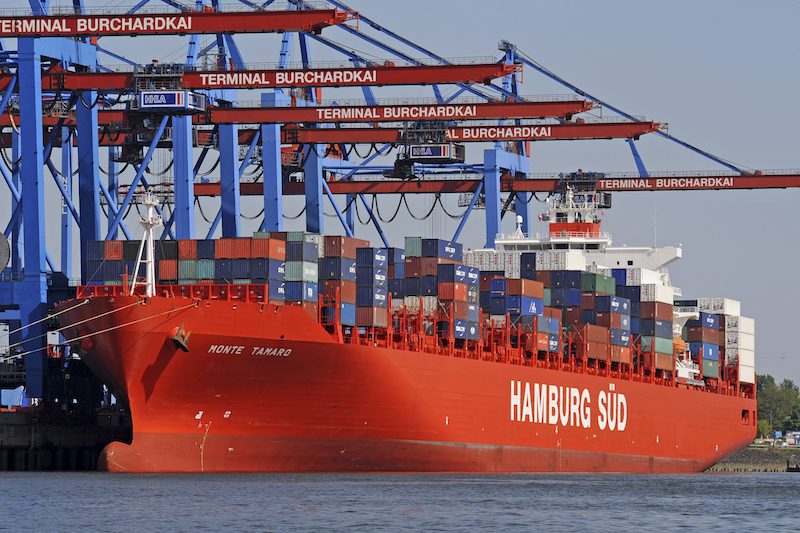Port of Los Angeles Sets June Cargo Record Amid Tariff Concerns
The Port of Los Angeles handled 892,340 Twenty-Foot Equivalent Units (TEUs) in June, marking an 8% increase compared to the same period last year and setting a new record for...

Ship docked at Port of Hamburg. File photo courtesy Hamburg Sued
By Emma-Victoria Farr
Aug. 19 (Bloomberg) — The port of Hamburg, Germany’s gateway to the Baltics and China, is adding jobs as a surge in sea freight boosted cargo handling to record levels in the first six months of the year.
Europe’s third-largest commercial harbor handled 4.8 million standard containers, or TEUs, an increase of 6.8 percent, Port of Hamburg Marketing said in a statement yesterday. General cargo handling rose 8.8 percent to 51.6 million tons, the highest on record for the first half.
“There are more workers employed in the handling terminals than in the boom year 2008,” said Ingo Egloff, a member of the executive board. “The port economy is specifically seeking and employing more workers.”
Freight volume is picking up as the shipping industry comes to grips with the overcapacity that triggered the worst price slump since containerization became global in the 1970s. A.P. Moeller-Maersk A/S, the world’s biggest container-shipping line, today raised its full-year profit forecast as a reduction in costs boosts earnings.
Hamburg Hafen & Logistik AG, which handles about 75 percent of the containers at the German port, created 50 jobs at the end of July. The GHB employment services provider plans to create another 60 posts this year, it said in a statement yesterday.
Turnover in Hamburg may reach 145 million tons this year, topping the 2008 record of 140 million tons, the port said. Imports, which climbed 7.4 percent to 2.5 million TEUs, are rising at a faster rate than exports as container traffic with China rose 13 percent to more than 1.4 million TEUs. Exports rose 6.3 percent to 2.3 million TEUs.
Transfer Hub
That more than compensated for a decline in traffic between Hamburg and Russian ports, which fell 3.8 percent to 330,000 TEUs. Traffic surged 33 percent with Africa and 13 percent with India.
Russia is Hamburg’s biggest trading partner after China with the German port serving as a transfer hub, moving cargo from deep-sea ships from Asia to smaller feeder vessels destined for the Baltic Sea.
Delays of 70 hours or more for ships carrying 6,000 TEUs to 7,000 TEUs and construction work continue to impede the traffic flow as more ultra-large container ships call at the port, it said.
Hamburg, located about 130 kilometers (80 miles) from the North Sea, has plans to deepen and widen the navigation channel on the River Elbe that currently prevents the new-generation vessels from leaving and entering the port fully loaded.
“The dynamics are poor, the port is run inefficiently, it is not yet in recovery,” Oliver Drebing, an analyst at SRH Alster Research in Hamburg, said by phone.
The global fleet of container ships that can carry 14,000 TEUs or more is forecast to triple by the end of 2016, with the biggest carrying more than 18,000 TEUs, according to the June Global Port Tracker report.
Copyright 2014 Bloomberg.

Sign up for gCaptain’s newsletter and never miss an update

Subscribe to gCaptain Daily and stay informed with the latest global maritime and offshore news


Stay informed with the latest maritime and offshore news, delivered daily straight to your inbox
Essential news coupled with the finest maritime content sourced from across the globe.
Sign Up